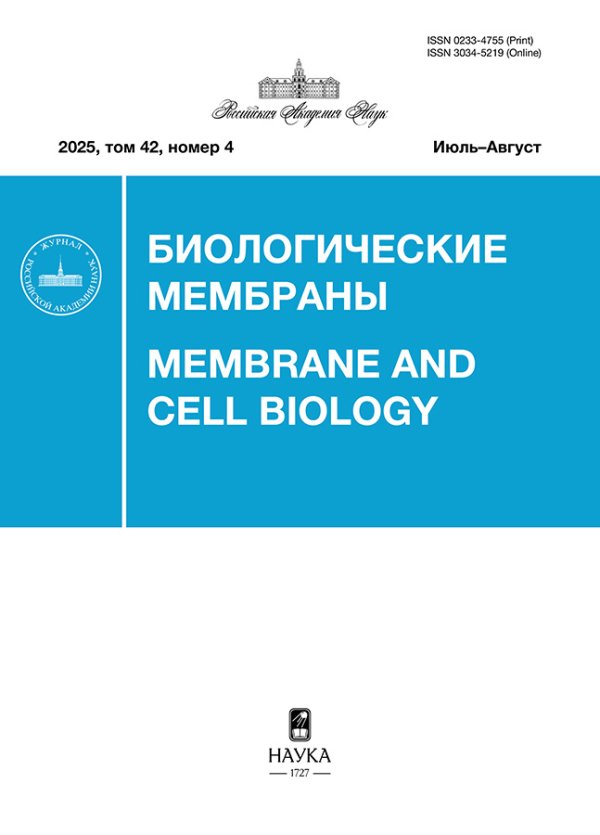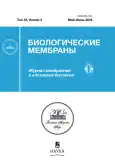Клонирование и гетерологическая экспрессия рецептора GPR120 из вкусовой ткани мыши
- Авторы: Черкашин А.П.1, Коваленко Н.П.1, Копылова Е.Е.1, Рогачевская О.А.1, Воронова Е.А.1, Колесников С.С.1
-
Учреждения:
- Институт биофизики клетки РАН, ФИЦ ПНЦБИ РАН
- Выпуск: Том 42, № 3 (2025)
- Страницы: 246-252
- Раздел: СТАТЬИ
- URL: https://bakhtiniada.ru/0233-4755/article/view/305566
- DOI: https://doi.org/10.31857/S0233475525030072
- EDN: https://elibrary.ru/tczcoc
- ID: 305566
Цитировать
Аннотация
Существование вкуса жирного наряду с общепризнанными вкусовыми модальностями (сладкое, горькое, умами, соленое и кислое) в настоящее время является предметом научной дискуссии и активного экспериментального анализа. Имеющиеся данные о сигнальном каскаде, запускаемом длинноцепочечными жирными кислотами (ЖК) во вкусовой клетке, свидетельствуют о его сходстве с каскадом трансдукции сладких, горьких и умами стимулов, однако начальные этапы трансдукции жирных стимулов до сих пор остаются нераскрытыми. В качестве одного из кандидатов на роль рецептора длинноцепочечных ЖК во вкусовой почке рассматривают представителя суперсемейства рецепторов, сопряженных с G-белками, – GPR120. В то же время имеющиеся в литературе сведения об участии GPR120 в восприятии ЖК периферической вкусовой системой крайне противоречивы. С целью создания платформы для дальнейшего изучения роли этого рецептора в трансдукции ЖК мы клонировали GPR120 из вкусовой ткани мыши и экспрессировали его в клетках линии НЕК-293. В отличие от исходных клеток НЕК-293, клетки НЕК-293, экспрессирующие рекомбинантный рецептор GPR120, генерировали Ca2+-ответы на аппликацию длинноцепочечных ЖК, что подтверждает литературные данные о сопряжении рецептора GPR120 с фосфоинозитидным каскадом и мобилизацией внутриклеточного Са2+. Представляется, что клетки HEK-293, экспрессирующие рецептор GPR120, могут быть полезной клеточной моделью для скрининга природных и синтетических лигандов этого рецептора и анализа его сопряжения с внутриклеточными сигнальными путями. Коэкспрессия GPR120 с другими сигнальными белками, вовлеченными в трансдукцию жирных стимулов во вкусовых клетках, может оказаться полезной для интерпретации ответов вкусовых клеток на стимуляцию ЖК.
Об авторах
А. П. Черкашин
Институт биофизики клетки РАН, ФИЦ ПНЦБИ РАН
Автор, ответственный за переписку.
Email: malehanova@mail.ru
Пущино, Московская обл., 142290 Россия
Н. П. Коваленко
Институт биофизики клетки РАН, ФИЦ ПНЦБИ РАН
Email: malehanova@mail.ru
Пущино, Московская обл., 142290 Россия
Е. Е. Копылова
Институт биофизики клетки РАН, ФИЦ ПНЦБИ РАН
Email: malehanova@mail.ru
Пущино, Московская обл., 142290 Россия
О. А. Рогачевская
Институт биофизики клетки РАН, ФИЦ ПНЦБИ РАН
Email: malehanova@mail.ru
Пущино, Московская обл., 142290 Россия
Е. А. Воронова
Институт биофизики клетки РАН, ФИЦ ПНЦБИ РАН
Email: malehanova@mail.ru
Пущино, Московская обл., 142290 Россия
С. С. Колесников
Институт биофизики клетки РАН, ФИЦ ПНЦБИ РАН
Email: malehanova@mail.ru
Пущино, Московская обл., 142290 Россия
Список литературы
- Jaime-Lara R.B., Brooks B.E., Vizioli C., Chiles M., Nawal N., Ortiz-Figueroa R.S.E., Livinski A.A., Agarwal K., Colina-Prisco C., Iannarino N., Hilmi A., Tejeda H.A., Joseph P.V. 2023. A systematic review of the biological mediators of fat taste and smell. Physiol. Rev. 103 (1), 855–918.
- Tsuruta M., Kawada T., Fukuwatari T., Fushiki T. 1999. The orosensory recognition of long-chain fatty acids in rats. Physiol. Behav. 66, 285–288.
- Chalé-Rush A., Burgess J.R., Mattes R.D. 2007. Multiple routes of chemosensitivity to free fatty acids in humans. J. Physiol. Gastroint .Liver Physiol. 292 (5), G1206–G1212.
- El-Yassimi A., Hichami A., Besnard P., Khan N.A. 2008. Linoleic acid induces calcium signaling, Src kinase phosphorylation, and neurotransmitter release in mouse CD36-positive gustatory cells. J. Biol. Chem. 283, 12949–12959.
- Dramane G., Abdoul-Azize S., Hichami A., Vogtle T., Akpona S., Chouabe C., Sadou H., Nieswandt B., Besnard P., Khan N.A. 2012. STIM1 regulates calcium signaling in taste bud cells and preference for fat in mice. J. Clin. Invest. 122, 2267–2282.
- Sclafani A., Zukerman S., Glendinning J.I., Margolskee R.F. 2007. Fat and carbohydrate preferences in mice: The contribution of alpha-gustducin and Trpm5 taste-signaling proteins. Am. J. Physiol. Regul. Integr. Comp. Physiol. 293, R1504–R1513.
- Ozdener M.H., Subramaniam S., Sundaresan S., Sery O., Hashimoto T., Asakawa Y., Besnard P., Abumrad N.A., Khan N.A. 2014. CD36- and GPR120-mediated Ca2 signaling in human taste bud cells mediates differential responses to fatty acids and is altered in obese mice. Gastroenterology. 146, 995–1005.
- Gaillard D., Laugerette F., Darcel N., El-Yassimi A., Passilly-Degrace A., Hichami A., Khan N.A., Montmayeur J.P., Besnard P. 2008. The gustatory pathway is involved in CD36-mediated orosensory perception of long-chain fatty acids in the mouse. FASEB J. 22, 1458–1468.
- Laugerette F., Passilly-Degrace P., Patris B., Niot I., Febbraio M., Montmayeur J.P., Besnard P. 2005. CD36 involvement in orosensory detection of dietary lipids, spontaneous fat preference, and digestive secretions. J. Clin. Invest. 115, 3177–3184.
- Abumrad N.A., el-Maghrabi M.R., Amri E.Z., Lopez E., Grimaldi P.A. 1993. Cloning of a rat adipocyte membrane protein implicated in binding or transport of long-chain fatty acids that is induced during preadipocyte differentiation. Homology with human CD36. J. Biol. Chem. 268 (24):17665–17668.
- Sclafani A., Ackroff K. 2018. Greater reductions in fat preferences in CALHM1 than CD36 knockout mice. Am. J. Physiol. Regul. Integr. Comp. Physiol. 315, R576–R585.
- Kimura I., Ichimura A., Ohue-Kitano R., Igarashi M. 2020. Free fatty acid receptors in health and disease. Physiol. Rev. 100, 171–210.
- Costanzo A., Liu D., Nowson C., Duesing K., Archer N., Bowe S., Keast R. 2019. A low-fat diet up-regulates expression of fatty acid taste receptor gene FFAR4 in fungiform papillae in humans: A co-twin randomised controlled trial. Br. J. Nutr. 122, 1212–1220.
- Murtaza B., Hichami A., Khan A.S., Shimpukade B., Ulven T., Ozdener M.H., Khan N.A. 2020. Novel GPR120 agonist TUG891 modulates fat taste perception and preference and activates tongue-brain-gut axis in mice. J. Lipid Res. 61, 133–142.
- Sclafani A., Zukerman S., Ackroff K. 2013. GPR40 and GPR120 fatty acid sensors are critical for postoral but not oral mediation of fat preferences in the mouse. Am. J. Physiol. Regul. Integr. Comp. Physiol. 305, R1490–R1497.
- Ancel D., Bernard A., Subramaniam S., Hirasawa A., Tsujimoto G., Hashimoto T., Passilly-Degrace P., Khan N.A., Besnard P. 2015. The oral lipid sensor GPR120 is not indispensable for the orosensory detection of dietary lipids in mice. J. Lipid Res. 56, 369–378.
- Romanov R.A., Rogachevskaja O.A., Bystrova M.F., Jeang P., Margolskee R.F., Kolesnikov S.S. 2007. Afferent neurotransmission mediated by hemichannels in mammalian taste cells. EMBO J. 26 (3), 657–667.
- Falomir-Lockhart L.J., Cavazzutti G.F., Giménez E., Toscani A.M. 2019. fatty acid signaling mechanisms in neural cells: Fatty acid receptors. Front Cell. Neurosci. 13, 162.
- Antollini S.S., Barrantes F.J. 2016. Fatty acid regulation of voltage- and ligand-gated ion channel function. Front. Physiol. 7, 573.
- Cartoni C., Yasumatsu K., Ohkuri T., Shigemura N., Yoshida R., Godinot N., Le Coutre J., Ninomiya Y., Damak S. 2010. Taste preference for fatty acids is mediated by GPR40 and GPR120. J. Neurosci. 30, 8376–8382.
- Montmayeur J.P., Fenech C., Kusumakshi S., Laugerette F., Liu Z.H., Wiencis A., Boehm U. 2011. Screening for G-protein-coupled receptors expressed in mouse taste papillae. Flavour Fragrance J. 26, 223–230.
- Matsumura S., Mizushige T., Yoneda T., Iwanaga T., Tsuzuki S., Inoue K., Fushiki T. 2007. GPR expression in the rat taste bud relating to fatty acid sensing. Biomed. Res. 28, 49–55.
- Galindo M.M., Voigt N., Stein J., van Lengerich J., Raguse J.D., Hofmann T., Meyerhof W., Behrens M. 2012. G protein-coupled receptors in human fat taste perception. Chem. Senses. 37, 123–139.
- Alvarez-Curto E., Inoue A., Jenkins L., Raihan S.Z., Prihandoko R., Tobin A.B., Milligan G. 2016. Targeted elimination of G proteins and arrestins defines their specific contributions to both intensity and duration of G protein-coupled receptor signaling. J. Biol. Chem. 291 (53), 27147–27159.
- Atwood B.K., Lopez J., Wager-Miller J., Mackie K., Straiker A. 2011. Expression of G protein-coupled receptors and related proteins in HEK293, AtT20, BV2, and N18 cell lines as revealed by microarray analysis. BMC Genomics. 12, 14.
- Kochkina E.N., Kopylova E.Е., Rogachevskaja O.A., Kovalenko N.P., Kabanova N.V., Kotova P.D., Bystrova M.F., Kolesnikov S.S. 2024. Agonist-induced Ca2+ signaling in HEK-293-derived cells expressing a single IP3 receptor isoform. Cells. 13, 562.
- Hirasawa A., Tsumaya K., Awaji T., Katsuma S., Adachi T., Yamada M., Sugimoto Y., Miyazaki S., Tsujimoto G. 2005. Free fatty acids regulate gut incretin glucagon-like peptide-1 secretion through GPR120. Nat. Med. 11 (1), 90–94.
Дополнительные файлы










